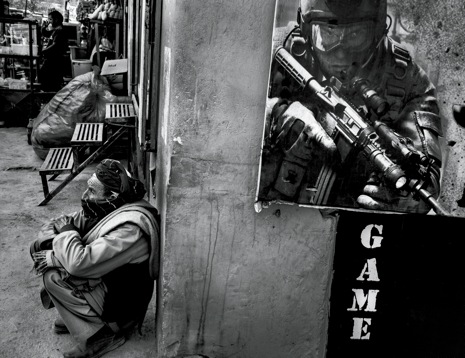In the eleven years since the American invasion of Afghanistan, Abdul Nasir has become a modern and prosperous professional. A worldly man in his late thirties, he smokes Marlboros, drives a Toyota, and follows Spanish soccer, rooting for Barcelona. He works in Kabul as a producer for Khurshid TV, one of the many private channels that have sprung up since 2004. He makes news and entertainment shows and sometimes recruiting commercials for the Afghan National Army, one of the country’s biggest advertisers. On weekends, he leaves the dust of the city and tends an apple orchard that he bought in his family’s village. We met for tea recently in a restaurant called Afghan International Pizza Express. Nasir wore jeans and a black T-shirt and blazer. His beard is closely trimmed, in the contemporary style.
Nasir recalled that when Afghanistan’s civil war broke out, in April, 1992, he was an agricultural student at Kabul University. He was from the sort of secular family that had flourished under the regime of Mohammad Najibullah, the country’s last Communist President. The Soviet Army had left in 1989, after ten years of fighting the American- and Saudi-backed guerrillas known as the mujahideen. Najibullah was a charismatic and ruthless leader, but, as the last of the Soviet troops departed, no one gave him much of a chance to remain in power. The Soviet Minister of Defense figured that Najibullah would last only a few months.
The regime, sustained by a flow of food and ammunition from the Soviet Union, held firm. The Afghan Army fought well, routing the mujahideen in a decisive battle for the city of Jalalabad. But in late 1991 the Soviet Union fell apart, leaving Najibullah and his fellow-Communists to fend for themselves. With their supplies running out, soldiers began to desert the Afghan Army. On April 17, 1992, Najibullah sought refuge in the United Nations compound in Kabul. The mujahideen poured into the capital, wild and hollow-eyed after years in the countryside.
“At first, the city was calm, there was hardly any fighting,” Nasir recalled. “It took me some time to realize that the city was calm because the militias were busy looting the government buildings. It took them a few days to get everything. When they finished, they came after everyone else.”
Kabul imploded: electricity disappeared from the city, police vanished, government services ceased, Kabul University closed. The mujahideen started grabbing pieces of the city. Karta Seh, the neighborhood in western Kabul where Nasir grew up, became a no man’s land poised amid three armed groups: Hezb-e-Wahdat, the militia of the Hazara minority, led by Abdul Ali Mazari; Hezb-e-Islami, led by Gulbuddin Hekmatyar, a commander famous for his bloodlust; and Jamiat-e-Islami, the army of Ahmad Shah Massoud, who was ostensibly part of a new government but who in fact controlled only a handful of Kabul’s neighborhoods. The border of Hezb-e-Wahdat’s turf, Nasir said, was Darulaman Road, just outside the window of Afghan International Pizza Express. As an ethnic Pashtun, Nasir had to stay away from the far side of Darulaman Road, where Hezb-e-Wahdat’s territory began. Some of his Pashtun friends had crossed over and never returned. “Hazaras were killing any Pashtun they could find,” Nasir said.
The militias fought each other continuously, and it was too dangerous to leave the house. “Hezb-e-Wahdat was right here, on the side of this road, and Massoud was just across the street, a hundred metres away,” Nasir said, twisting around in his chair and pointing to a hill overlooking Karta Seh. “Hekmatyar was down the road.” He twisted around again, pointing to the west. “The mujahideen were stealing everything—jewelry, cars, bikes. They were raping girls, raping boys.” Some of the Hezb-e-Wahdat fighters crossed into Karta Seh, bursting into Nasir’s family’s house and punching holes through the walls in the neighborhood to create an aboveground tunnel network. The family had no access to food, and Nasir ached from hunger. He could venture out only when the militiamen called an occasional ceasefire.
The family held on for a year in Karta Seh, and then, during a lull in the fighting, moved to Nasir’s uncle’s apartment, in a Soviet-built complex called Macroyan, about a mile away. Macroyan was largely under the control of a fourth group, an Uzbek militia called Junbish-e-Milli, led by a warlord of exceptional brutality named Abdul Rashid Dostum, who had fought for the Soviets. Massoud’s forces were close by, but the two groups were separated by the Kabul River.
Over the next three years, tens of thousands of Afghans died in the civil war. From Hekmatyar’s base, outside the city, he rained Scud missiles on Kabul. The various militias, in a frenzy to mark their territory, carpeted the city with mines. There were so many mines in Kabul that, in the mid-nineteen-nineties, according to United Nations figures, an average of fifty people per week stepped on them, risking death and terrible injury. The city’s monuments, great and banal—the Darulaman Palace, the mausoleum of King Nadir Shah, a socialist-realist relic called the Soviet Cultural Center—were blasted and burnt.
In the autumn of 1996, the Taliban, armed and backed by the Pakistani military, reached the outskirts of Kabul. On its march across the country, the Taliban had vanquished every militia in its path. All that remained was Massoud’s army, which was still in Kabul.
Around this time, Nasir travelled to his ancestral village, Deh Afghanan, about twenty-five miles west of Kabul, for his wedding day. The morning of the ceremony, he went to his mother’s grave to pray, and to tell her of his marriage. Nasir could see the Taliban forces a few hundred yards away. That day, fighting broke out between the Taliban and Massoud’s forces, and an artillery shell landed in the village, killing five of Nasir’s relatives. The wedding proceeded, and so did the funerals. Nasir shared his wedding feast with the grieving family. “It was the saddest and the happiest day of my life,” he said.







